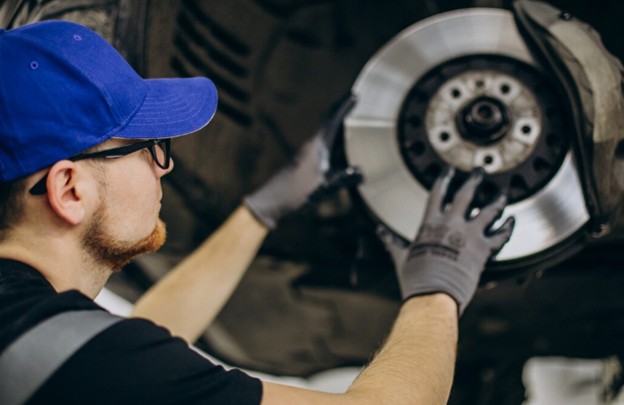The Trusted Team for Garage Doors Brisbane Homeowners Can Rely On
June 27, 2025XRP Cloud Mining: Wall Street Consortium Has Already Made Its Arrangement
June 27, 2025
Brake noises. We’ve all heard them, and frankly, they’re about as welcome as a flat tire on a Friday night. As a business deeply invested in vehicle maintenance and repair, we know these sounds can range from mildly annoying to downright alarming. This article aims to equip you with the knowledge to diagnose and potentially address these common brake pad noises, saving you time, money, and maybe even a little sanity.
Identifying the Culprit: Decoding the Sounds
Each sound your brakes make can offer clues about the underlying issue. Think of it as a diagnostic symphony, where clicks, grinds, and squeals each play a distinct role. Let’s break down these common offenders.
- Clicks: A clicking sound, usually heard when you first apply the brakes or when driving at low speeds, often points to loose brake pads or worn hardware. The pads might be shifting within the caliper. So, it is vital to inspect the clips, shims, and other components designed to keep the pads secure. These components are responsible for maintaining proper fit and function, and a simple adjustment or replacement could silence the noise and restore confidence in your braking system.
- Grinds: A grinding noise is almost always a sign of serious trouble, typically indicating that the brake pads have worn down completely, and the metal backing plate is now rubbing against the rotor. This is metal on metal contact, which is not only ear grating, but also destructive to your rotors. Continuing to drive in this condition will score and damage the rotors, ultimately leading to a more expensive repair involving both pad and rotor replacement.
- Squeals: Squealing brakes can be caused by a variety of factors, including worn pads, glazed pads, or even simply moisture on the rotor surface. It’s important to note that some brake pads, especially those designed for high performance, are naturally prone to squealing, particularly when cold. However, if the squealing persists or becomes excessively loud, it warrants further investigation, as it could also indicate the need for new pads or rotor resurfacing.
Taking Action: From DIY to Calling in the Pros
So, you’ve identified the noise. Now what? Here’s a tiered approach to tackling the problem, ranging from simple checks you can perform yourself to knowing when it’s time to bring in the experts.
First, start with a visual inspection. Check the brake pad thickness through the wheel, if possible, or by removing the wheel for a closer look. If the pads appear thin, they likely need replacement. Furthermore, examine the rotors for scoring or damage. Severe damage means you should consult a professional, as it is crucial for a safe repair.
Second, consider the age and condition of your brake hardware. Over time, clips, shims, and springs can corrode or lose their tension, contributing to noise and reduced braking performance. Replacing these components along with the brake pads is a smart move, ensuring that everything works together as intended. You can purchase a brake hardware kit at most auto parts stores, but it’s a good idea to have some mechanical experience before attempting the job.
Finally, know when to throw in the towel. If you’re not comfortable working on your brakes, or if the noise is accompanied by other symptoms like reduced braking power or a soft brake pedal, it’s time to seek professional help. Brakes are a critical safety system, and it’s not worth risking your well being to save a few bucks. A qualified mechanic can accurately diagnose the problem, perform the necessary repairs, and ensure your braking system is functioning optimally.
Prevention is Key: Maintaining Your Brakes for a Quieter Ride
Like anything else on your vehicle, regular maintenance is essential for keeping your brakes in top condition and minimizing unwanted noises. A little preventative care can go a long way in extending the life of your brakes and keeping them quiet.
- Regular Inspections: Have your brakes inspected at least once a year, or more frequently if you do a lot of driving in stop and go traffic or hilly terrain. This allows you to catch problems early before they escalate into more significant issues. You can do a quick visual check yourself, but a professional inspection is always recommended for a thorough assessment.
- Proper Lubrication: Apply brake lubricant to the appropriate contact points, such as the caliper slides and the back of the brake pads, during brake service. This helps to prevent sticking and binding, reducing the likelihood of noise and ensuring smooth operation. However, be sure to use a lubricant specifically designed for brake components, as some products can damage rubber seals.
- Quality Parts: When replacing brake pads or rotors, opt for quality parts from reputable manufacturers. Cheap brake pads may save you a few dollars upfront, but they often wear out faster and can produce more noise and brake dust. Investing in quality components will ultimately provide better performance, longer life, and a quieter ride.
Brake noises can be a real headache, but with a little knowledge and proactive maintenance, you can keep your braking system quiet and reliable. Remember, safety always comes first, so don’t hesitate to seek professional help if you’re unsure about anything. After all, a quiet and effective braking system is something we can all appreciate.
